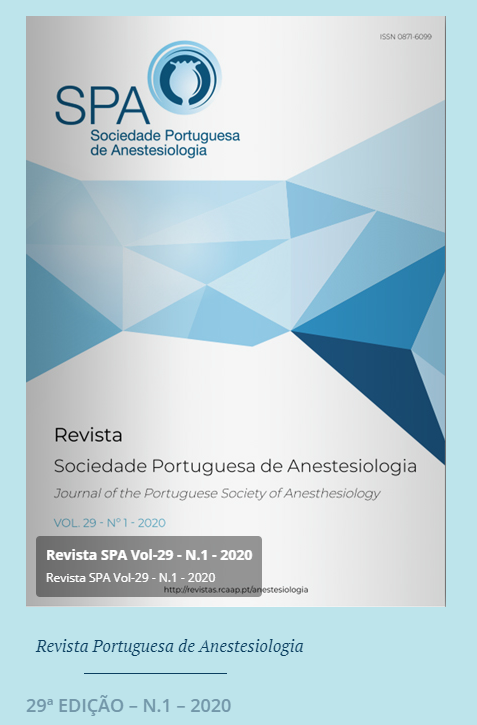Propofol Administration in the Induction Phase of General Anesthesia in Portugal
DOI:
https://doi.org/10.25751/rspa.18834Palavras-chave:
Anestesia Geral; Anestésicos Intravenosos; Anestesiologistas; Inquéritos e Questionários; Portugal; PropofolResumo
A administração adequada de propofol por via intravenosa durante a indução da anestesia geral implica um bom conhecimento da farmacocinética e da farmacodinâmica, um bom entendimento de como a anestesia altera a consciência e a habilidade de interpretar corretamente a monitorização dos sinais vitais. Este trabalho pretende avaliar a prática usual dos anestesiologistas em Portugal no que diz respeito à administração de propofol por via intravenosa durante a indução da anestesia geral.
Estudo observacional transversal, descritivo e analítico realizado através de um questionário enviado por correio eletrónico a todos os médicos internos e especialistas em Anestesiologia de vários hospitais portugueses. O questionário apresentava um cenário convencional (Sujeito do sexo masculino, 50 anos, 60kg, 160 cm, ASA I, submetido a anestesia geral com propofol a 1%) e incluía 10 questões relacionadas com a administração de propofol durante a indução. Foi realizada análise descritiva dos dados obtidos através do programa SPSS 23.0®.
Responderam ao inquérito 118 médicos, sendo que, a maioria eram especialistas há mais de 5 anos (56,9%). Baseados no cenário apresentado, a maioria dos anestesiologistas administraria uma dose de 60 mg de propofol na indução, a uma velocidade superior a 1200 mL/horas, avaliariam a perda de consciência através da perda do reflexo palpebral, o que se refletiria num índica BIS de 60. A maioria dos participantes medem a pressão arterial do doente a cada 5 minutos e nunca utilizaram sistemas de infusão alvo-controlada.
Downloads
Referências
Portal da Saúde, Mds Portugal. [accessed Feb 2019] Available from: http:www. portaldasaude.pt
Lemos P, Guedes A, Mourão J, Lima JF, Veiga J, Chedas M, et al. 2017 Census: are there enough anaesthesiologists in Portugal?Acta Med Port. 2018; 31: 254–64.
Ghoneim MM. Incidence of and risk factors for awareness during anaesthesia.Best Pract Res Clin Anaesthesiol. 2007; 21: 327–43.
Tarnal V, Vlisides PE, Mashour GA. The neurobiology of anesthetic emergence. J Neurosurg Anesthesiol. 2015; 28: 250–5. doi: 10.1097/ANA.0000000000000212.
Eger EI. Characteristics of anesthetic agents used for induction and maintenance of general anesthesia.Am J Health Syst Pharm. 2004; 61 Suppl 4: S3-10.
Schnider TW, Minto CF, Shafer SL, Gambus PL, Andresen C, Goodale DB, et al. The influence of age on propofol pharmacodynamics. Anesthesiology. 1999; 90: 1502–16.
Diprivan 10 mg/ml (1%) emulsion for injection or infusion - Summary of Product Characteristics (SmPC) - (eMC). [accessed Feb 2019] Available from: https://www.medicines.org.uk/emc/product/5492/smpc
Kazama T, Ikeda K, Morita K, Ikeda T, Kikura M, Sato S. Relation between initial blood distribution volume and propofol induction dose requirement.Anesthesiology. 2001; 94: 205–10.
Adachi YU, Satomoto M, Higuchi H, Watanabe K. The determinants of propofol induction time in anesthesia. Korean J Anesthesiol. 2013; 65: 121.
Blum J, Kochs E, Forster N, Schneider G. The influence of injection rate on the hypnotic effect of propofol during anesthesia: a randomized trial. PLoS Clin Trials. 2006; 1: e17.
Peacock JE, Lewis RP, Reilly CS, Nimmo WS. Effect of different rates of infusion of propofol for induction of anaesthesia in elderly patients.Br J Anaesth. 1990; 65: 346–52.
Ferreira AC, Nunes CS, Castro AI, Ferreira AL, Amorim P. Propofol Requirements for Anesthesia Induction Show Wide Individual Variability, Independently of Age, Gender, Weight and Height. In: Proceedings from the American Society of Anesthesiologists; 2015.
Mashour GA, Shanks A, Tremper KK, Kheterpal S, Turner CR, Ramachandran SK,et al. Prevention of intraoperative awareness with explicit recall in an unselected surgical population: a randomized comparative effectiveness trial. Anesthesiology. 2012; 117: 717–25.
Monk TG, Saini V, Weldon BC, Sigl JC. Anesthetic management and one-year mortality after noncardiac surgery.Anesth Analg. 2005; 100: 4–10.
Lindholm ML, Träff S, Granath F, Greenwald SD, Ekbom A, Lennmarken C, et al. Mortality within 2 years after surgery in relation to low intraoperative bispectral index values and preexisting malignant disease. Anesth Analg. 2009; 108: 508–12.
Chaudhri S, White M, Kenny GN. Induction of anaesthesia with propofol using a
target-controlled infusion system. Anaesthesia. 1992; 47: 551–3.
Absalom AR, Glen JB, Zwart GJ, Schnider TW, Struys MM. Target-controlled infusion:
a mature technology. Anesth Analg. 2016; 122: 70–8.
Downloads
Publicado
Como Citar
Edição
Secção
Licença
Os artigos estão livremente disponíveis para serem lidos, descarregados e partilhados a partir do momento da sua publicação.
A RSPA reserva-se o direito de comercialização do artigo enquanto parte integrante da revista (na elaboração de separatas, por exemplo). O autor deverá acompanhar a carta de submissão com a declaração de cedência de direitos de autor para fins comerciais.
Relativamente à utilização por terceiros a Revista da SPA rege-se pelos termos da licença Creative Commons “Atribuição – uso Não-Comercial (CC BY-NC).
Após publicação na RSPA, os autores ficam autorizados a disponibilizar os seus artigos em repositórios das suas instituições de origem, desde que mencionem sempre onde foram publicados.


